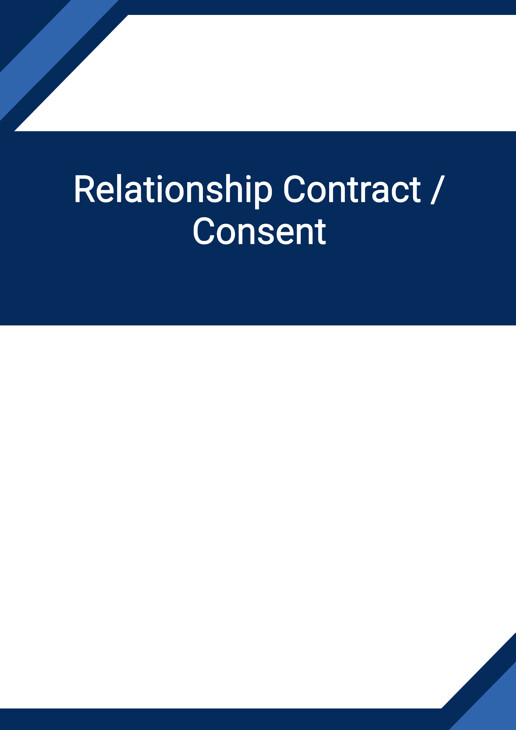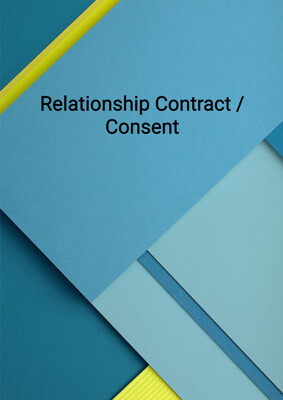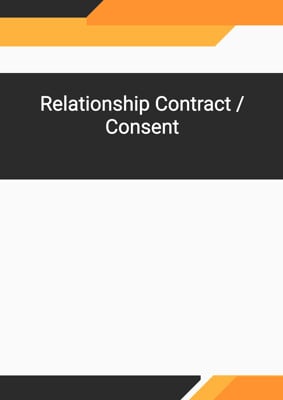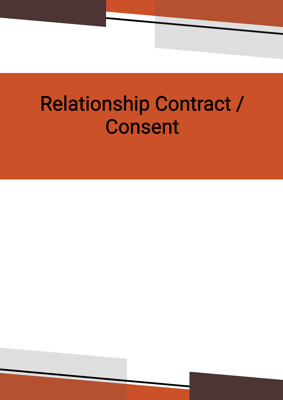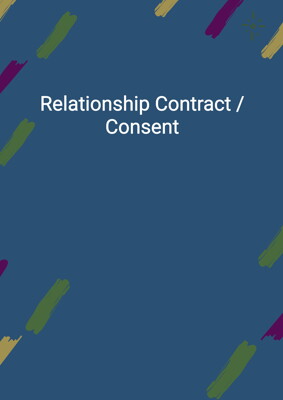How to Tailor the Document for Your Need?
01
Create Document
Fill in the details of the parties. You can click the "Fill with Member’s Information" button to complete it with information saved to your account.
02
Fill Information
Please fill in any additional information by following the step-by-step guide on the left hand side of the preview document and click the "Next" button.
03
Get Document
When you are done, click the "Get Document" button and you can download the document in Word or PDF format.
04
Review Document
Please get all parties to review the document carefully and make any final modifications to ensure that the details are correct before signing the document.
Document Preview
Document Description
The Relationship Contract/Consent is a document that outlines the terms and conditions of a voluntary and mutual consensual personal relationship between two parties, referred to as Party A and Party B. The document is entered into by both parties to establish guidelines and boundaries for their relationship within the context of their employment with the Company.
The document begins with a brief introduction, stating the purpose and intent of the agreement. It emphasizes that the personal relationship between Party A and Party B does not violate the Company's employment policy and that both parties agree to adhere to all of its terms.
Section 1 of the document focuses on the Company's employment policy. It states that prior to signing the agreement, both parties have received and reviewed the policy and acknowledge that their personal relationship does not violate it. It also highlights the Company's stance against unwelcome or offensive conduct, including sexual harassment, and confirms that neither party has been coerced into the personal relationship as a result of employment or sexual harassment.
Section 2 of the document addresses the mutual consent of both parties. It outlines the understanding and agreement between Party A and Party B regarding their personal relationship. It emphasizes that the relationship is voluntary and consensual, and both parties commit to acting professionally towards each other and not allowing the relationship to negatively impact their work. It also specifies that they will not participate in decision-making processes that could affect each other's performance review, salaries, promotion, working hours, or career. Additionally, it states that they will refrain from engaging in public displays of affection or behavior that could create a hostile work environment for others.
Section 2.2 of the document highlights the freedom of both parties to end the social relationship at any time. It establishes that if the relationship ends, both parties agree to maintain professionalism, inform the Company to protect their rights against discrimination, and refrain from retaliating against each other or participating in decision-making processes that could affect each other's employment.
Section 2.3 addresses conflicts of interest that may arise due to the personal relationship. It states that if a conflict of interest is determined by the Company, one or both parties may need to transfer to another department. If the conflict cannot be resolved, one party may have to resign or be demoted. The Company will provide options where possible, and if no choice is made, the Company may make the decision. Both parties agree not to make any claims against the Company for wrongful dismissal or workplace discrimination in such instances.
Section 3 of the document addresses the enforceability of the agreement. It states that if any provision is found to be invalid or unenforceable, the remaining provisions will still be in effect. The parties are allowed to come to an agreement and substitute the invalid provision with a similar enforceable term.
Section 4 clarifies that the contract does not grant any rights to third parties to enforce its terms.
Section 5 states that the agreement and the relationship between the parties will be governed by and interpreted in accordance with jurisdiction state law.
The document concludes with the signatures of Party 1 and Party 2, indicating their agreement to the terms and conditions outlined in the Relationship Contract/Consent.
How to use this document?
1. Review the Company's employment policy attached to the agreement to ensure compliance.
2. Understand that the personal relationship between Party A and Party B should not violate the Company's employment policy.
3. Act professionally towards each other and avoid allowing the relationship to negatively impact work.
4. Refrain from participating in decision-making processes that could affect each other's performance review, salaries, promotion, working hours, or career.
5. Avoid engaging in public displays of affection or behavior that could create a hostile work environment for others.
6. Remember that the personal relationship is voluntary and consensual, and either party is free to end it at any time.
7. Maintain professionalism and inform the Company if the personal relationship ends to protect against discrimination.
8. Do not retaliate against each other and avoid participating in decision-making processes that could affect each other's employment.
9. Be aware that conflicts of interest may require one or both parties to transfer to another department.
10. Understand that unresolved conflicts of interest may result in resignation or demotion.
11. Consider the options provided by the Company in resolving conflicts of interest.
12. Do not make any claims against the Company for wrongful dismissal or workplace discrimination in conflict situations.
13. Remember that if any provision in the agreement is found to be invalid or unenforceable, the remaining provisions will still be in effect.
14. Come to an agreement and substitute any invalid provision with a similar enforceable term.
15. Understand that the contract does not grant any rights to third parties to enforce its terms.
16. Comply with jurisdiction state law, which governs the agreement and the relationship between the parties.
17. Sign the agreement to indicate agreement to the terms and conditions outlined in the Relationship Contract/Consent.
